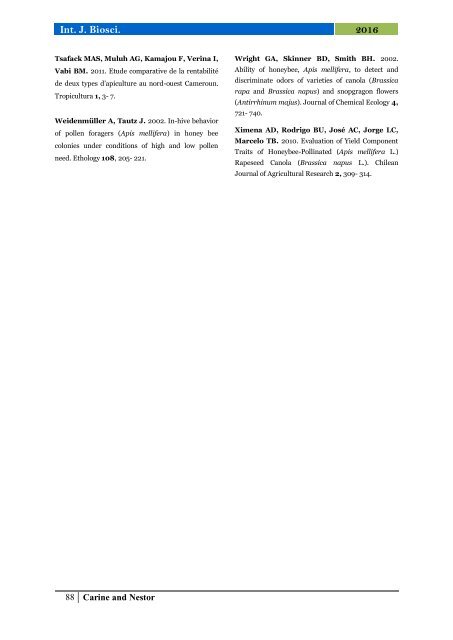Pollination efficiency of Apis mellifera adansonii Latreille (Hymenoptera: Apidae) on Croton macrostachyus (Euphorbiaceae) flowers at Dang, Ngaoundéré, Cameroon
To evaluate the impact of Apis mellifera adansonii on fruit and seed yields of Croton macrostachyus, the foraging and pollinating activities of worker bees were studied in Ngaoundéré. From May to June in 2013 and 2014, the experiments were carried out on 375 inflorescences divided in three treatments: two treatments differentiated according to the presence or absence of protection regarding honeybee and other insects visits; the third protected and uncovered when flowers were open, to allow honeybee visits. Worker’s seasonal rhythm of activity, their foraging behavior on flowers, their pollination efficiency, the fruiting rate and percentage of normal seeds were evaluated. Results show that, honeybee foraged on C. macrostachyus flowers throughout its whole blooming period. This bee intensely harvested nectar and pollen. The mean number of individuals foraging simultaneously on 1000 flowers was 21.25 in 2013 and 56.14 in 2014. The mean duration of a visit per flower was 6.07 sec in 2013 and 5.69 sec in 2014. The mean foraging speed was 10.61 flowers/min in 2013 and 12.28 flowers/min in 2014. The fruiting rate and the percentage of normal seeds of unprotected inflorescences were significantly higher than those protected from insects. Through its pollination efficiency, this bee provoked a significant increase of fruiting rate by 44.82% (2013) and 61.85% (2014) as well as the percentage of normal seeds by 78.60% (2013) and 76.69% (2014). The installation of honeybee colonies close to C. macrostachyus populations could be recommended to increase fruit and seed yields and to increase honey production in the region.
To evaluate the impact of Apis mellifera adansonii on fruit and seed yields of Croton macrostachyus, the foraging and pollinating activities of worker bees were studied in Ngaoundéré. From May to June in 2013 and 2014, the experiments were carried out on 375 inflorescences divided in three treatments: two treatments differentiated according to the presence or absence of protection regarding honeybee and other insects visits; the
third protected and uncovered when flowers were open, to allow honeybee visits. Worker’s seasonal rhythm of activity, their foraging behavior on flowers, their pollination efficiency, the fruiting rate and percentage of normal seeds were evaluated. Results show that, honeybee foraged on C. macrostachyus flowers throughout its whole blooming period. This bee intensely harvested nectar and pollen. The mean number of individuals foraging simultaneously on 1000 flowers was 21.25 in 2013 and 56.14 in 2014. The mean duration of a visit per flower was 6.07 sec in 2013 and 5.69 sec in 2014. The mean foraging speed was 10.61 flowers/min in 2013 and 12.28 flowers/min in 2014. The fruiting rate and the percentage of normal seeds of unprotected inflorescences were significantly higher than those protected from insects. Through its pollination efficiency, this bee provoked a significant increase of fruiting rate by 44.82% (2013) and 61.85% (2014) as well as the percentage of normal seeds by 78.60% (2013) and 76.69% (2014). The installation of honeybee colonies close to C. macrostachyus populations could be recommended to increase fruit and seed yields and to increase honey production in the region.
Create successful ePaper yourself
Turn your PDF publications into a flip-book with our unique Google optimized e-Paper software.
Int. J. Biosci. 2016<br />
Tsafack MAS, Muluh AG, Kamajou F, Verina I,<br />
Vabi BM. 2011. Etude compar<strong>at</strong>ive de la rentabilité<br />
de deux types d’apiculture au nord-ouest Cameroun.<br />
Tropicultura 1, 3- 7.<br />
Weidenmüller A, Tautz J. 2002. In-hive behavior<br />
<str<strong>on</strong>g>of</str<strong>on</strong>g> pollen foragers (<str<strong>on</strong>g>Apis</str<strong>on</strong>g> <str<strong>on</strong>g>mellifera</str<strong>on</strong>g>) in h<strong>on</strong>ey bee<br />
col<strong>on</strong>ies under c<strong>on</strong>diti<strong>on</strong>s <str<strong>on</strong>g>of</str<strong>on</strong>g> high and low pollen<br />
need. Ethology 108, 205- 221.<br />
Wright GA, Skinner BD, Smith BH. 2002.<br />
Ability <str<strong>on</strong>g>of</str<strong>on</strong>g> h<strong>on</strong>eybee, <str<strong>on</strong>g>Apis</str<strong>on</strong>g> <str<strong>on</strong>g>mellifera</str<strong>on</strong>g>, to detect and<br />
discrimin<strong>at</strong>e odors <str<strong>on</strong>g>of</str<strong>on</strong>g> varieties <str<strong>on</strong>g>of</str<strong>on</strong>g> canola (Brassica<br />
rapa and Brassica napus) and snopgrag<strong>on</strong> <strong>flowers</strong><br />
(Antirrhinum majus). Journal <str<strong>on</strong>g>of</str<strong>on</strong>g> Chemical Ecology 4,<br />
721- 740.<br />
Ximena AD, Rodrigo BU, José AC, Jorge LC,<br />
Marcelo TB. 2010. Evalu<strong>at</strong>i<strong>on</strong> <str<strong>on</strong>g>of</str<strong>on</strong>g> Yield Comp<strong>on</strong>ent<br />
Traits <str<strong>on</strong>g>of</str<strong>on</strong>g> H<strong>on</strong>eybee-Pollin<strong>at</strong>ed (<str<strong>on</strong>g>Apis</str<strong>on</strong>g> <str<strong>on</strong>g>mellifera</str<strong>on</strong>g> L.)<br />
Rapeseed Canola (Brassica napus L.). Chilean<br />
Journal <str<strong>on</strong>g>of</str<strong>on</strong>g> Agricultural Research 2, 309- 314.<br />
88 Carine and Nestor


















